| gltaylor Global Moderator 




Global Moderator Posts: 1,794 Member is Online | Feb 21, 2022 at 6:14pm Steve Davis, huntemhigh, and 7 more like this QuoteEdit Post by gltaylor on Feb 21, 2022 at 6:14pmHello friends,This document is intended to help in the process of selecting the best Hammer bullet for your rifle and hunting application. Before beginning your journey with Hammers, please read all of the guidance information offered by Steve and Brian at Hammer Bullets. Hammer bullets are not like any bullets you have loaded before. They are unique from other monolithic solid copper bullets. I suggest that you will be very pleased with the ease of finding a good load, the velocity you gain, the accuracy you achieve and the overall performance of whichever Hammer you choose. Everyone starting to load Hammer Bullets would benefit from reading the attached document below. Selecting a Hammer Bullet Minimum Twist Each Hammer bullet has a recommended minimum twist listed on the product ordering page. The preferred stability factor (SG) is 1.5 minimum at sea level. A stability factor of 1.5 or higher is needed to achieve full BC value and expected terminal ballistics. A marginal stability factor (less than 1.5SG) hinders a bullet's ability to stay on track and open reliably for proper terminal performance. A SG of 1.5 or higher will keep a bullet oriented point first on impact and promote proper deformation of the frontal area for good terminal performance. Choose a bullet weight that is comfortably within the minimum twist stated on your rifle. It is fine to shoot with more than the recommended twist (faster twist). In fact, extra stability is a good thing. If hunting at low elevation and cold temperatures, it is recommended to run faster than minimum required twist rates. Note that when referring to a rifle's twist rate, a 1:8" twist rate is faster than a 1:10". Verifying Twist Before choosing a bullet it is wise to verify the actual twist of your barrel. It is common for both factory and custom barrels to be slightly different than the indicated twist stamped on the barrel. Twists often vary as much as 1/2" from the indicated twist! This means that if your bullet calls for a minimum twist of 1:8" and your barrel is actually a 1:8.5, your Stability Factor can be significantly (negatively) affected. Note that if you go down in bullet weight in your caliber, lighter bullets generally require less twist to achieve higher stability factors (SG). Verifying your actual twist rate will ensure that the bullets you ultimately select are correct for your barrel and will give you the SF you desire (and need) for good optimum performance. There are numerous video clips demonstrating how to measure your twist using a cleaning rod, brass brush and patch. Select Your Likely Shot Distance Too often, individuals choose a bullet to give them the absolute maximum BC for the longest imaginable distance. This is often unnecessary and may limit your rifle to less than optimum performance at realistic distances. Determine the typical distance that you will actually shoot. For the vast majority of hunters, this will be 400 yds., or less. Make a Bullet Speed Chart There are several examples of this posted on the Hammertime Forum. Basically, you choose the weight range of bullets you wish to compare for best performance in Your rifle, based upon Your twist and speed. This is best accomplished using your rifle while working up loads and chronographing them. Developing numerous loads may be prohibitive during the current shortage of components – but this is actually the best course of action. You want to find out which bullets perform best in your rifle. If you find two bullets are very close in performance, go with the heavier bullet. An alternate approach is to go to the Hammer Hunter and Absolute Hammer load data threads and look up results for your rifle caliber and bullet weights. Numerous loads are shared by Forum members. This should give you a relative idea of what to expect from your rifle. These loads were developed in different rifles, so your results may vary slightly. However, speeds others achieve should be roughly indicative of what your rifle should produce. The best results are, of course, obtained by developing loads in your rifle. As an example, data from the Forum was used to generate the two spreadsheets listed below. There was much data for both the 7mm-08 Rem and the 7mm Rem Mag. Other calibers are obviously available on the Forum spreadsheets, but many list a smaller number of bullet choices. You could use these and add some of your own. 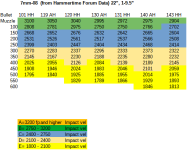 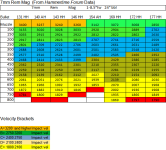 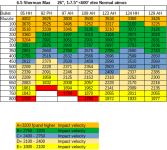
Select the best bullet weight range for the game you expect to hunt. Note that this should involve several different weights. The Velocity Chart you develop will give you an indication of the best combination of (1) Weight, (2) Distance and (3) Speed for your rifle. Note that there may be some surprises here! Several people have found that a bullet weight different from their initial choice proved to be the best overall performer once all the numbers come in! Also keep in mind that you may well end up using a bullet much lighter than you have traditionally used. Most find that Hammers hit way above their weight class in terminal performance. Velocity Brackets The concept of Velocity Brackets is not new. One of the Forum members has refined this concept based upon animal reactions to the shot, over hundreds of animals from small deer to water buffalo. Hammers work well at an impact velocity down to 1800 fps. The nose will deform properly and the shank will typically penetrate fully at 1800 fps. What we have determined through on-animal testing is that overall performance and penetration improves with increased velocity and (SG) stability factor. This means that your choice of bullet should include consideration of the best compromise between the velocity your rifle is capable of and the distance to which your bullet can maintain at least 1800 fps. You want the maximum velocity possible at the distance you intend to shoot. (See Velocity Brackets listed above.) Stability Factor (SG) It is generally accepted that a stability factor (SG) of 1.5 is considered minimum for optimum stability of a bullet in flight. Bullet stability (the ability of a bullet to maintain point forward and return to that orientation when disturbed) depends upon two primary factors: Gyroscopic Stability (SG) and Dynamic Stability. Dynamic Instability can occur at both bullet launch and, most commonly, as the bullets slows down and transitions into and through the transonic zone (about 1,200 fps velocity). With a SG of 1.5, bullets do not normally experience dynamic instability at launch within normal acceleration velocities. Dynamic Instability at the transonic region is typically encountered when shooting at extremely long distances - most often not encountered during hunting scenarios – and below the recommended minimum impact speed for Hammers (1,800 fps). Gyroscopic stability (SG) is achieved by spinning the bullet. Bullet RPM is established by the rate of rifling twist of the barrel and the muzzle velocity. The minimum stability factor is achieved at the point the bullet leaves the muzzle. Once the bullet leaves the barrel significant forces begin to act upon the bullet. Forward velocity begins to decline immediately as the bullet travels downrange due to drag (air friction). RPM decays, but RPM loss is insignificant compared to loss of velocity. For this reason, stability of a bullet INCREASES as it travels downrange. RPMs stay essentially constant while bullet velocity decreases due to air drag. We are unaware of any way to calculate or estimate terminal performance of a bullet. However, post mortem examinations of animals after a kill are demonstrating some consistent and interesting results. It is becoming quite apparent that higher RPMs and higher stability factors (SG) contribute significantly to straight line, deep penetration through tissue, bones and liquids. Bullets impacting with higher SG and greater velocity tend to be less affected by these tougher impacts. Veering off or curving of the bullet tends to be minimized or non-existent in wound channels from these higher stability impacts, regardless of velocity. Slower bullet velocities also benefit from higher stability. Some of the Hammer Bullets have been subjected to what could only be described as torture tests and none have failed. We have yet to destroy a Hammer by launching it at hyper velocities and insanely high RPMs up into the hundreds of thousands of RPMs! Bullets have been launched at in excess of 4,200 fps in 7.5 twist barrels with no ill effects to the bullets. Straight line penetration and absolute tissue damage has been the rule. More testing is forthcoming. The chart below illustrates the higher stability factors possible using different twists at nominal, easily attainable velocities. These numbers should be looked at before you re-barrel your rifle next time! 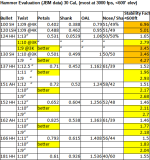 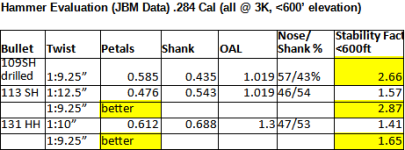 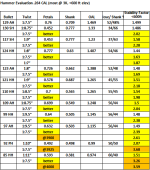
|
Last edited:

